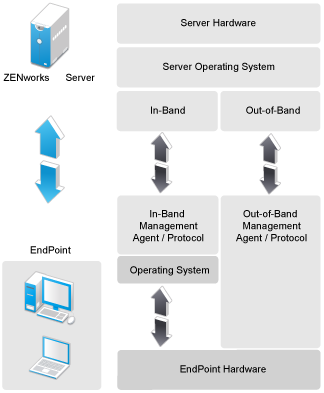1.0 Overview
Out-of-band management uses a dedicated management channel, in contrast to the traditional resource management technologies that use the same infrastructure for managing both the system and operations. For example, ZENworks uses the operating system resources like networking and system APIs to establish a management communication channel between the managed device and server.
The out-of-band management solution is independent of the platform and operating system, and can also manage devices that do not have the operating system active. For example, some out-of-band technologies such as Intel AMT and IPMI manage devices that are currently shut down, but connected to the power socket.
Some out-of-band technologies use additional dedicated hardware connections specifically for management tasks. For example, to enable an active and reliable connection between a management console and a managed device, the IPMI technology uses a dedicated serial connection from the management console to the managed device. However, other technologies such as Intel AMT establish connectivity between a management server and a managed device by using an independent Ethernet network, which is different from the network connection used for an operating system.
The in-band management architecture uses the operating system services. The following figure differentiates an out-of-band management infrastructure from an in-band management infrastructure:
Figure 1-1 In-Band Versus Out-of-Band Management

The out-of-band management technologies have been in existence for quite some time now, and standardization of some of them has taken place in last decade, using standards like Desktop and mobile Architecture for System Hardware (DASH), Systems Management Architecture for Server Hardware (SMASH), and the Alert Standard Format (ASF). The adoption of such technologies is becoming part of the mainstream, with hardware platform vendors like Intel promoting Intel Active Management Technology (AMT) and Intelligent Platform Management Interface (IPMI), and implementing these technologies in their chipsets and architecture.
With green computing being a significant priority for desktop and server administrators today, the need to alter the configuration of devices on demand and manage the power states of these devices is a significant use case today. ZENworks allows power management of endpoint devices that have the Intel AMT capability.